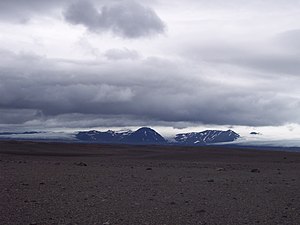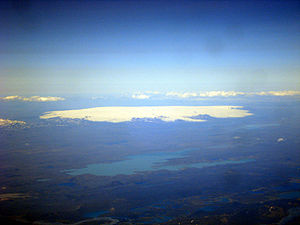Hofsjokull
| Hofsjokull | ||
|---|---|---|
|
Satellite image of the independent glacier Hofsjökull, Langjökull left, Vatnajökull right |
||
| height | 1765 m | |
| location | Iceland | |
| Coordinates | 64 ° 49 '28 " N , 18 ° 49' 23" W | |
|
|
||
| Type | Subglacial volcano | |
| particularities | Caldera under the glacier | |
|
Hofsjökull, Múlajökull on the left and Þjórsárjökull glacier on the right |
||
|
Aerial view to the north. In front of the glacier is the lake Þórisvatn , behind it in the west the mountains of the Vatnsnes peninsula , in the east Tröllaskagi . |
||
There are two glaciers named Hofsjökull in Iceland . One is its own large glacier shield exactly in the geographical center of the country, the second is a former side glacier of Vatnajökull .
The Hofsjökull glacier cap
The third largest glacier in Iceland is located in the west of the Icelandic highlands .
Its area is 925 km², at the highest point it measures 1765 m . However, a strong retreat has been noticed in him too, similar to the other large glaciers in Iceland.
Surname
Its name comes from the estate Hof í Vesturdal in Skagafjörður.
In the south of Iceland, however, it was called Arnarfellsjökull after the mountain Arnarfell hið mikla in the south-east .
shape
It is roughly circular in shape and from its highest point it slopes down fairly evenly in all directions. The only exception are the rock needles and walls of the Hásteinar in the south of the summit, which consist of acidic rock and tower over their surroundings by approx. 100 m.
Glacier tongues
The most famous glacier tongues of the Hofsjökull ice cap are seen clockwise from the Arnarfell: Múlajökull to the southeast, Blautukvíslarjökull to the south, Blöndujökull to the west, Kvíslajökull to the west-northwest and Þjórsárjökull to the east.
The deepest glaciated point is under the Múlajökull glacier tongue at 470 m and is therefore approx. 130 m deeper than the surrounding land.
Upstream mountains
In addition to the Árnafell already mentioned, there are other mountains in front of the glacier shield : Álftabrekkur in the northwest, Miklafell and Klakkur in the east, Hjartafell and Ólafsfell in the south and Blágnípa in the west.
Glacial rivers
A number of large glacial rivers have their origin in the Hofsjökull glacier cap: Blanda , Þjórsá , Jökulfall , Austari- and Vestari-Jökulsá .
Volcanism under the Hofsjökull glacier cap
The glacier lies on an east-west aligned volcanic zone that connects the eastern volcanic and rift zone in Iceland with the western ( Reykjanes - Langjökull ).
To the west under the glacier is a caldera , the presence of which was unknown until 1983. It is 6–7 km wide, its area is 30–40 km² and it reaches a depth of up to 650 m and can easily be identified on satellite images. At times, one could measure series of small earthquakes that indicate magma movements. However, nothing is known about the time when this caldera was formed or the last eruptions from the volcano.
The associated volcanic system is up to 90 km long and 30–35 km wide.
There is a shield volcano in the southwest .
Traces of a few smaller lava eruptions could be detected on the slopes of the glacier volcano. They are younger than 10,000 but older than 1,000 years. The craters themselves are now under the ice sheet, the lava fields emerge from underneath.
Geologists sometimes consider the Kerlingarfjöll volcanic system to be that of Hofsjökull.
Highland slopes
The glacier can be seen from the Sprengisandsleið highland road ![]() that runs between it and Vatnajökull. The Kjalvegur highland road
that runs between it and Vatnajökull. The Kjalvegur highland road ![]() runs west between it and Langjökull .
runs west between it and Langjökull .
The small independent glacier Hofsjökull in southeast Iceland
In southeast Iceland, between the easternmost glacier tongue of Vatnajökull (Axajökull) and Þrándarjökull , at 64 ° 37 ′ 0 ″ N , 15 ° 3 ′ 0 ″ W , there is a smaller glacier (area about 4 km²), which is also called Hofsjökull wearing.
See also
- Iceland glaciers
- Volcanoes in Iceland
- Geography of Iceland
- List of mountains and elevations in Iceland
Individual evidence
- ↑ Helgi Björnsson et al. a .: Climate Change response of Vatnajökull, Hofsjökull and Langjökull. 2006, p. 3.
- ↑ Íslandshandbókin. 2. bindi. 1989, p. 877.
- ↑ a b Íslandshandbókin. 1989, p. 878.
- ^ Hofsjökull in the Global Volcanism Program of the Smithsonian Institution (English); accessed: September 19, 2010
- ↑ Ari Trausti Guðmundsson: Living Earth. Facets of the geology of Iceland. Mál og Menning, Reykjavík 2007, p. 193.
- ↑ The caldera can also be seen very well on computer representations made with the help of these images. See Þorleifur Einarsson: Geology of Iceland. Rocks and Landscape. 3rd edition Reykjavík 2005, p. 160.
- ↑ cf. u. a. Hofsjökull accessed on March 18, 2010: Flank fissures north and east of the icecap have produced basaltic lava flows during the Holocene.
- ↑ Hofsjökull in the Global Volcanism Program of the Smithsonian Institution (English), s. O.
Web links
Photos and videos
Scientific contributions
- Hofsjökull in the Global Volcanism Program of the Smithsonian Institution (English)
- Ari T. Guðmundsson: Jarðhiti í Hofsjökli . Náttúrufræðingurinn, 66.árg., 1996 (PDF file, Icelandic)
Sport at Hofsjökull
- http://www.isafold.de/langhof97 Report on a trekking tour with photos
- Skiing on the (larger) Hofsjökull (English)



